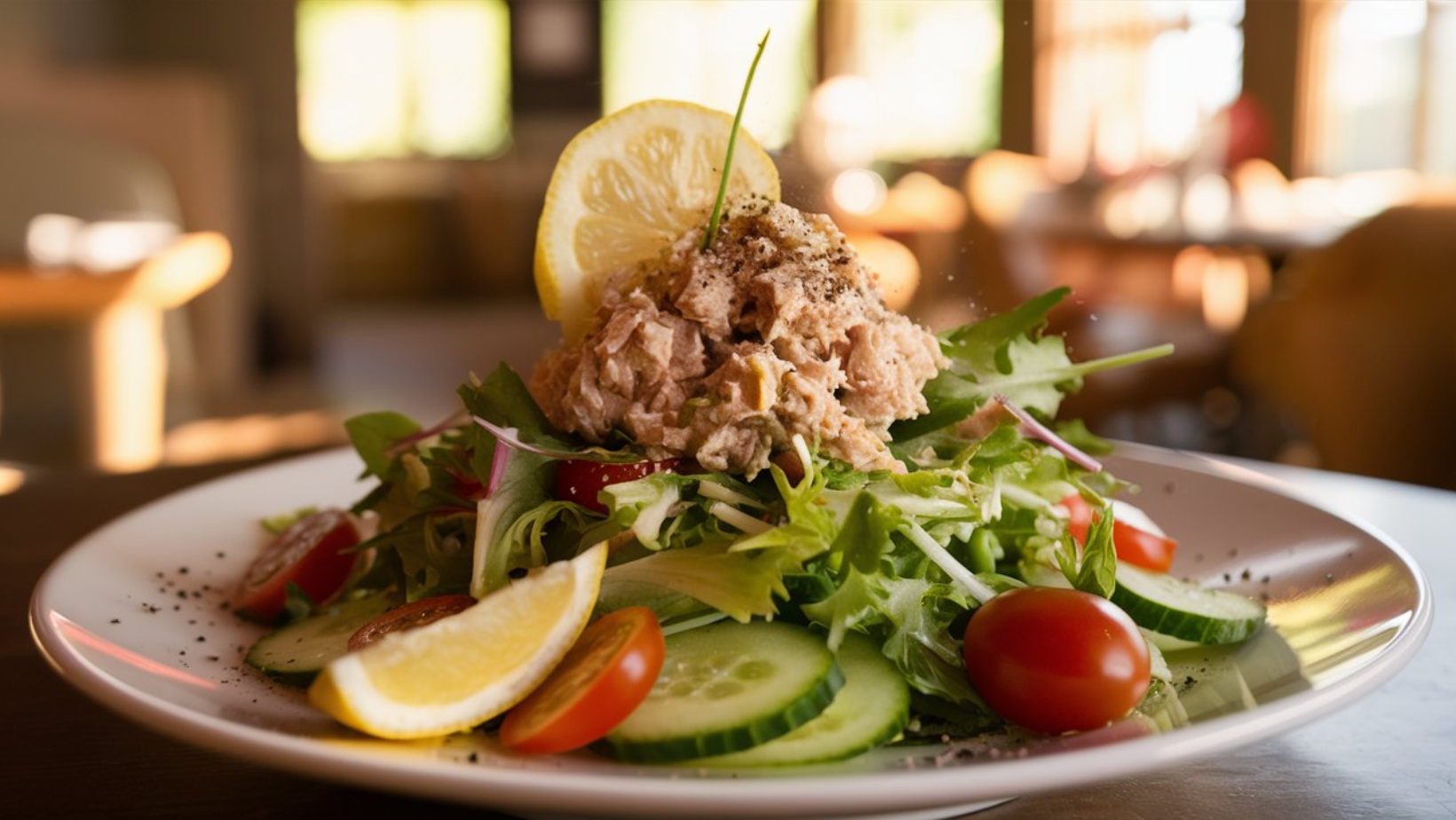Introduction to the Allure of Restaurant Tuna Salad
Why does restaurant tuna salad always taste so good? This question intrigues many who have tried replicating the dish at home only to find that something seems missing. The secret lies not just in the ingredients themselves but in how they are combined, prepared, and presented. From the use of high-quality tuna to the meticulous culinary techniques and the ambiance of dining out, every element adds a layer of complexity and delight. This article will explore the myriad reasons behind the exceptional taste of restaurant tuna salad, diving into the ingredients, preparation methods, presentation styles, and sensory experiences that make it a menu favorite.
Introduction to the Popularity of Tuna Salad
The Global Appeal of Tuna Salad in Restaurants
Tuna salad has become a staple on restaurant menus worldwide, and its popularity isn’t just by chance. The dish’s appeal involves more than taste; it includes the entire dining experience. Restaurants have mastered turning simple ingredients into something extraordinary.
Enhancing the Dining Experience
The sensory allure of dining in a restaurant significantly boosts the enjoyment of tuna salad. The carefully crafted ambiance, from lighting to music, enhances your dining pleasure. Every detail, including the table setting, is designed to engage your senses and improve the taste of your meal.
The Art of Presentation
Presentation also plays a crucial role in the appeal of tuna salad. Restaurants often serve it more artfully than at home, focusing on color and composition. Such attention to detail makes the dish as visually pleasing as it is flavorful.
In summary, the popularity of tuna salad in restaurants stems not only from the food but also from the overall experience. This full-sensory approach to dining turns a simple meal into an unforgettable event.
Ingredients Used in Restaurant Tuna Salad
High-Quality Ingredients
The foundation of a superb restaurant tuna salad starts with its ingredients. Premium, often sustainably sourced albacore tuna is crucial. This type of tuna, fresher and richer in flavor than typical canned varieties, forms the backbone of the dish. The choice of mayonnaise also plays a significant role. Many chefs prefer organic or artisan mayonnaise for its less processed, more nuanced flavor, which complements the delicate taste of high-quality tuna without overwhelming it.
Secret Ingredients that Enhance Flavor
Chefs often elevate tuna salad with unique, gourmet spices and creative dressings beyond the typical mayo and relish combination. Adding ingredients like capers, Dijon mustard, or a splash of lemon juice can introduce a refreshing zing that boosts the natural flavors of the tuna. Fresh herbs like dill, parsley, or chives not only add a pop of color but also bring a fresh aromatic quality that can’t be achieved with dried herbs. These thoughtful additions help transform the simple tuna salad into a gourmet dish.
This focus on high-quality ingredients and the inclusion of unique, flavorful elements is what sets restaurant tuna salad apart from its homemade counterpart, ensuring each bite is a taste sensation. Explore the best brands of tuna in Mexico for top-quality options that could elevate your home-cooked meals to restaurant standards.
Culinary Techniques in Preparation
Advanced Cooking Techniques
The culinary techniques employed in restaurant kitchens are pivotal in enhancing the flavors and textures of tuna salad. One popular method is marinating the tuna. Chefs often soak the tuna in a blend of olive oil, lemon juice, and herbs before cooking. This not only infuses the fish with robust flavors but also tenderizes it, creating a melt-in-your-mouth texture that elevates the overall dish.
Grilling or searing the tuna instead of using canned varieties introduces another layer of flavor. This technique adds a subtle smokiness and a pleasing char that is rarely achieved with pre-cooked tuna. The use of fresh tuna steaks, cooked precisely to retain moisture and tenderness, showcases the chefs’ commitment to quality and flavor.
Mixing and Combining Elements
The art of mixing the salad is equally important. Unlike the hurried mixing at home, chefs in restaurants carefully fold the ingredients to ensure that each component maintains its integrity. This gentle mixing prevents the tuna from becoming overly mashed, allowing diners to enjoy the distinct textures of the fish, along with the crunch of freshly diced celery or onions and the creaminess of the dressing.
Balancing the flavors is a craft in itself. Chefs skillfully adjust the amount of each ingredient to ensure that no single flavor overpowers another. This balance is what often makes restaurant tuna salad taste more refined and harmonious compared to homemade versions.
Through these specialized techniques—marinating, grilling, and careful mixing—restaurant chefs transform ordinary ingredients into a culinary delight. This meticulous approach to preparation not only enhances the flavor and texture of the tuna salad but also ensures that it stands out as a signature dish on the menu. explore The Secret to the BEST Deli Tuna Salad which discusses how simple ingredients can be elevated to create a standout dish.
Presentation and Experience
Visual Appeal and Presentation
The presentation of tuna salad in restaurants is often as important as the taste itself. A visually appealing plate can make the dish more enticing, enhancing the overall dining experience. Chefs take great care in arranging the salad components artfully on the plate, using elements of color and texture to create a visually stunning dish. The use of vibrant greens, ripe cherry tomatoes, and a colorful medley of garnishes not only adds to the aesthetic appeal but also complements the flavors of the tuna.
Sensory Experience in Restaurant Settings
The setting in which a meal is served plays a crucial role in how it’s perceived. The restaurant’s ambiance, whether it’s elegant decor, soft lighting, or soothing music, sets the stage for a memorable experience. This controlled environment is designed to enhance the sensory experience, making the food taste even better.
Each presentation detail, from plateware to food placement, aims to maximize visual impact. For instance, a dark plate can make the salad’s colors pop, making them more appetizing. Attention to detail extends to garnishes as well. Finely chopped herbs or a drizzle of exquisite dressing can elevate the dish from ordinary to extraordinary.
Restaurants meticulously design the presentation and sensory experience so the dish tastes good and also looks and feels luxurious. This approach makes restaurant tuna salad stand out for many, transforming a simple meal into a refined culinary adventure.
Consumer Perception and Trends
Perception of Value and Quality
The perception of value and quality in restaurant tuna salad heavily relies on its ingredients and preparation. Diners often link the use of premium ingredients like sustainably sourced albacore or yellowfin tuna and organic mayonnaise with a higher quality dish. This perceived quality can justify a higher price point, elevating the salad from a simple meal to a sought-after experience.
Moreover, the care and expertise evident in the flavor balance and ingredient quality boost diners’ overall perception of the restaurant. When customers notice the enhanced taste from high-quality ingredients and expert preparation, they view the establishment as superior in its culinary offerings.
Trends in Restaurant Tuna Salad Offerings
Recent years have seen a shift towards health-conscious and environmentally sustainable choices in restaurant menus. This trend is evident in the ingredients and methods used for dishes like tuna salad. For example, using organic produce, non-GMO ingredients, and environmentally sustainable tuna reflects a commitment to health and sustainability that resonates with modern diners.
Restaurants are also embracing global flavors, adding ingredients like wasabi mayonnaise, sesame oil, or miso to their tuna salads. This fusion of flavors not only expands the appeal of tuna salad but also keeps it relevant in the evolving culinary scene.
By aligning with consumer preferences for quality, health, and sustainability, restaurants enhance their appeal and stay competitive.

